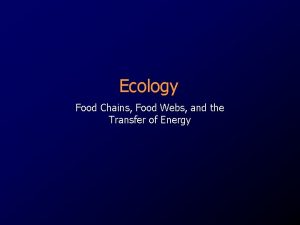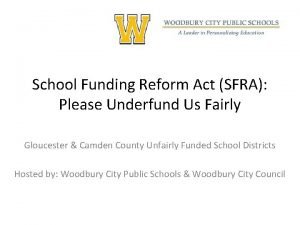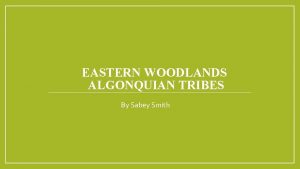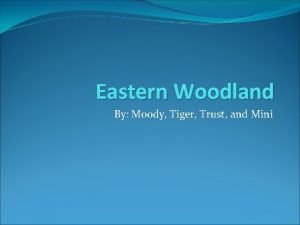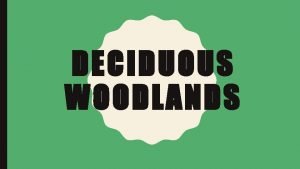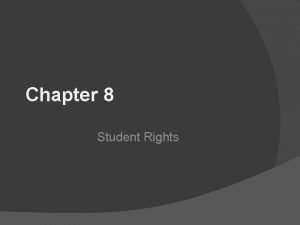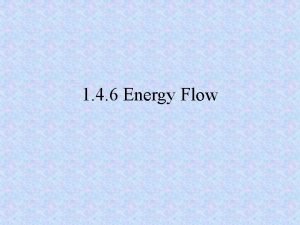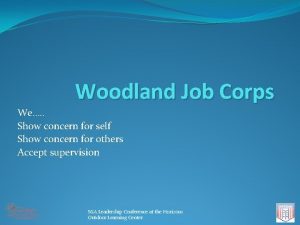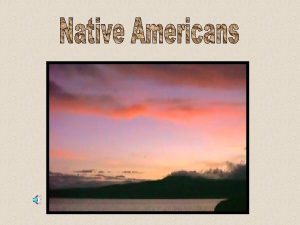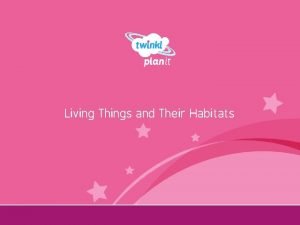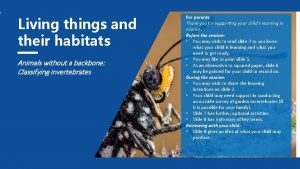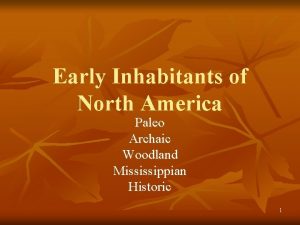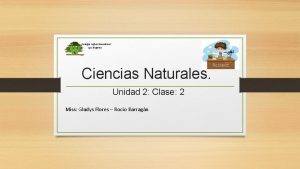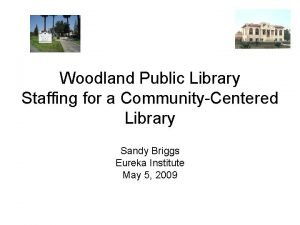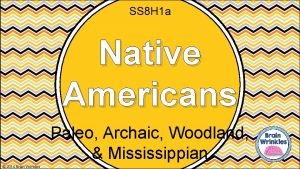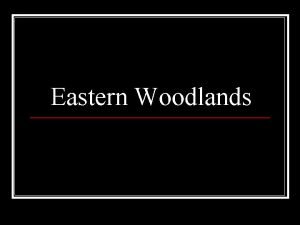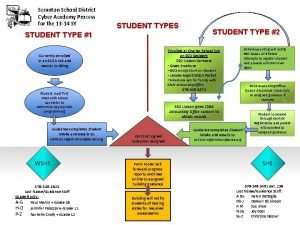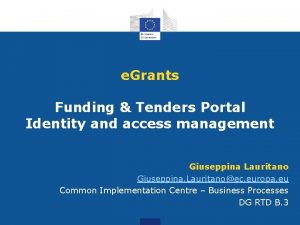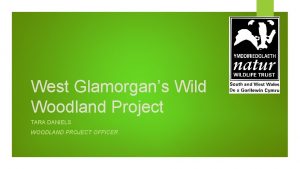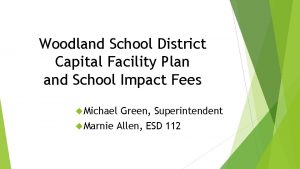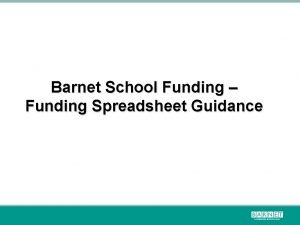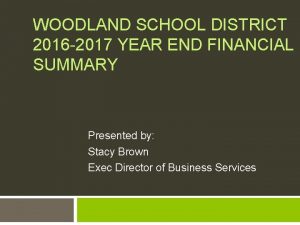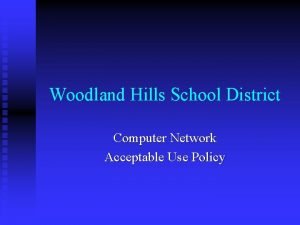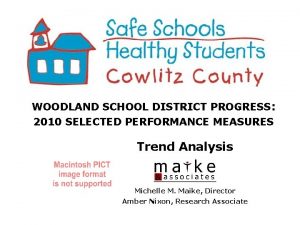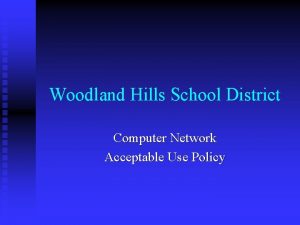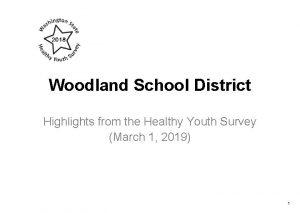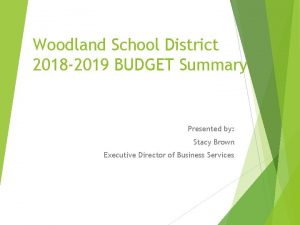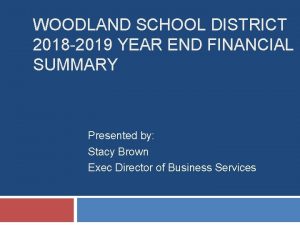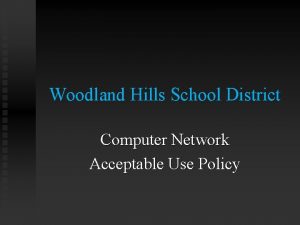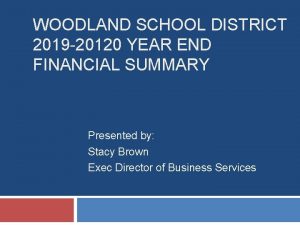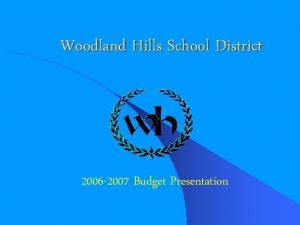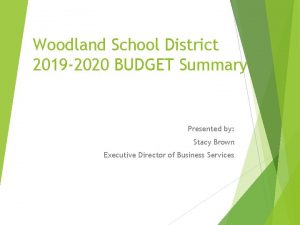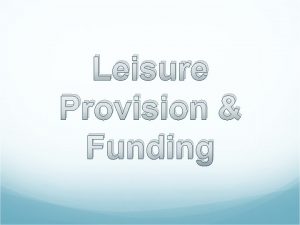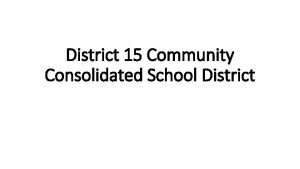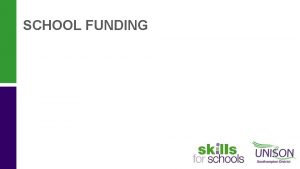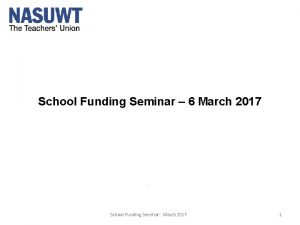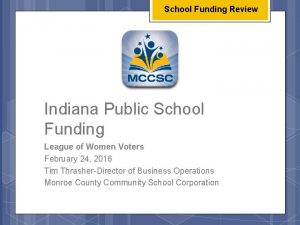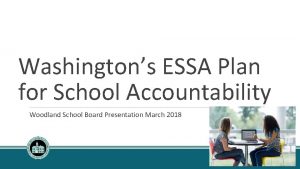Woodland School District School Funding in WA and





























- Slides: 29

Woodland School District School Funding in WA and 2020 -21 BUDGET Summary PRESENTED BY: STACY BROWN EXECUTIVE DIRECTOR OF BUSINESS SERVICES

WA School Funding Funds School accounting requires separate and distinct funds to account for revenues and expenditures General Fund – all operating revenues and expenditures of the district Capital Projects Fund – revenues consist of bond proceeds, impact fees, funds transferred from GF, contributions from the KWRL districts. Expenditures include large projects, such as new buildings, property, roof replacements, portables, and KWRL projects. Debt Service Fund – all debt is paid from this fund. We only have bond debt, so the revenues are made up of property taxes and investment earnings. Expenditures are for bond principle and interest. ASB Fund – called a special revenue fund this fund has special rules that allow schools to raise funds for student use. However, the funds still belong to the district (not the students). Transportation Vehicle Fund – can only be used for purchasing buses. Revenues consist of contributions from KWRL districts and state depreciation funds. Trust Fund – fund also has different accounting rules than the other funds. Scholarship donations and interest earnings are deposited to the fund and student scholarships are paid.

WA State Funding – General Fund Local/Other Revenues Local Sources Property Tax/Local Effort Assistance (LEA) Student Fines/Fees (Participation, Class Fees, Book Fines) Food Service Program Fees Daycare Program Fees (Parents, DSHS, Cowlitz Tribe) Donations Funds from Other Districts (KRL and Partners In Transition Pgm) Funds from ESD (BEST Teacher Program) Non-High Funds (from Green Mountain)

WA State Funding – General Fund State Revenues State Apportionment – Prototypical School Model Formula driven based on the average annual full time equivalency (AAFTE) students served in a typical school (not Alternative Schools) School level funding for teachers, librarians, counselors, nurse/psych, administrators, secretaries, paraprofessionals, custodians and security salaries and benefits District level funding for technology, facilities, maintenance, grounds, Classified Supervisors, District-level Administrators and other district staff (District Office, Business Office) salaries and benefits Materials, Supplies and Operating Costs (MSOC’s) for schools and district support School level for Career and Technical Education (WMS and WHS) salaries, benefits and MSOC’s. Additional funds for Running Start, Teacher professional development, substitutes

WA State Funding – General Fund State Revenues (Cont’d) State Apportionment – Other/Categorical Alternative Learning – based on the AAFTE students multiplied by an amount set by the legislative budget Special Education – formula based on AAFTE students with Individualized Education Plan (IEP) multiplied by an amount set by the legislature Special Education Safety Net – funds applied for separately based on high cost/high need students Learning Assistance Program (LAP) – remediation program, targeted for K-4 English and Language Arts (ELA). Formula based on previous year district AAFTE and district poverty level. LAP High Poverty – additional allocation based on school poverty level (eligible for Columbia Elementary and TEAM High)

WA State Funding – General Fund State Revenues (Cont’d) State Apportionment – Other/Categorical (Cont’d) State Transitional Bilingual (STBP) – referred to as ELL. Funding to provide services to students who’s first language is not English, Formula based on the AAFTE of students qualified (specific score on WAAS test). Additional allocation for students who have exited the program Highly Capable (Hi-C) – funding to provide services to students with accelerated learning capabilities. Formula based on a 5% of district AAFTE (regardless of how many students qualify to participate in the program) Student Transportation Allocation Reporting System (STARS)– funding to provide transportation of students to and from school. Formula based on number of to/from school destinations, number of students riding the bus and land area of the district

WA State Funding – General Fund State Revenues (Cont’d) Miscellaneous State Programs (Allocations and Competitive) National Board Reimbursement (Allocation) – funds to reimburse district for stipends made to Nationally Board Certified teachers (we currently have 18) Dual Immersion Grant (Competitive) – funds applied for and granted to support the Dual Immersion program ($34, 000 19 -20 and $30, 000 20 -21) Homeless Student Stability Education Program (Competitive) – funds applied for and granted to support our homeless students ($15, 00 20 -21) Misc Competitive – funds applied for and granted for misc programs such as Emergency Repairs, College Ready Math Curriculum for WHS, Food Service Equipment, WHS Robotics program, Grad Rate Improvement for TEAM High

WA State Funding – General Fund Federal Revenues Federal – Allocations (Noncompetitive) IDEA (Individuals with Disabilities Education Act) – funding allocated to supplement state funds to provide services to the special education students. Funds received for Kindergarten through age 21 and for Preschool. Carl Perkins - funding provided to supplement state Career and Technical Education (CTE) programs. Title One – remediation funds provided to supplement state remediation funds (LAP). We have decided to use LAP funds at the elementaries and Title One funds at WMS. Title II (High Quality Teachers and Principals) – funds used to provide professional development for certificated staff. Tile III (English Language Learner) – funding allocated to supplement programs serving ELL students. Used for class materials, curriculum and staff PD. Title IV (Student Support and Academic Enrichment) – a portion of the funds must be used to provide a well-rounded education, improve school conditions for student learning and improve the use of technology. Funds used for mental health services, technology training for staff and to reimburse students for college credits taken and earned at WHS.

WA State Funding – General Fund Federal Revenues Federal Grants (Competitive) Mc. Kinney Vento Grant – 3 year grant received 19 -20 through 21 -22 to supplement services to our homeless population

WA School Funding – General Fund Expenditures The General Fund expenditures are separated into programs. Some programs are offset by only state funds or only Federal Funds (and match up with the state and federal revenues) while others include revenues from multiple sources. Basic Education (01), ALE (02), CTE (31 and 34), Districtwide Support (97) – the expenditures in these programs are the programs offset by general apportionment revenues. However, there are not enough apportionment funds to cover all expenditures, so local levy funds are also used. Special Education (21 and 24) – these expenditures are predominantly covered by State (21) and Federal (24) funds. As we are required to serve all students according to their IEP’s Special Education is also underfunded and we use approximately $400, 000 to $700, 000 per year in levy funds to support the program. Carl Perkins (38), Title One (51), Title II/IV (52), Title III (64) – these program expenditures match up with the corresponding revenues and are only from Federal sources. The dollars budgeted and spent are determined by the Federal allocation

WA School Funding – General Fund Expenditures LAP (55), Miscellaneous State (58), ELL (65) and Hi-C (74) – these programs are funded by state funds only and are called the categorical programs. Food Service (98) – this program pays for all salaries, benefits, the Sodexo contract and supplies for the district meal service program. The program is funded by student fees (local), state, Federal and levy funds. Transportation – this program accounts for all to/from transportation for the Kalama, Woodland, Ridgefield and La. Center school districts KWRL). The program is funded by state apportionment funds. Expenditures that are not covered by state apportionment funds are split among the 4 districts (based upon each district’s percentage of hours and miles). The other districts make monthly payments to Woodland. Daycare (88) – the WCC and YCC daycare programs are funded mostly by user fees. The program has also been approved by DSHS as a site for low income families, so we receive monthly payments from DSHS. Other Locally funded Programs (69 & 89) – these programs include expenditures to offset any donations that we receive from private donors, WEA, the PTSA and the Southwest Community Foundation (to name a few). This program also includes the expenditures of the Family Resource Center that are not covered by other state or federal funds. This includes support of the center itself, the school food pantries and the Back to School Bash.

Enrollment History – Budget to Actual ENROLLMENT HISTORY 2 600 BUDGETED ACTUAL 2 500 2 400 2 300 2 200 2 100 2 000 BUDGETED ACTUAL 13 -14 2 160 2 232 14 -15 2 184 2 212 15 -16 2 175 2 279 16 -17 2 273 2 317 17 -18 2 389 2 420 18 -19 2 460 2 461 19 -20 2 474 2 477 20 -21 2 474 2 438

20 -21 Budget Historical Revenue/Exp/Fund Balance Summary AUDITED BUDGET 2018 $33, 065, 331 2019 $37, 461, 158 2020 2021 $∆ TOTAL REVENUE 2017 $29, 931, 746 $39, 901, 177 $42, 416, 999 $2, 515, 822 6. 3% EXPENDITURES TOTAL EXPENDITURES $30, 055, 378 $33, 484, 153 $37, 192, 715 $40, 118, 711 $42, 728, 924 $2, 610, 213 6. 5% SURPLUS / DEFICIT OTHER FINANCING SOURCES / USES Other Financing Sources Other Financing Uses NET CHANGE IN FUND BALANCE ($123, 632) ($418, 822) $268, 443 ($217, 534) ($311, 925) ($94, 391) $250, 000 ($38, 359) $88, 009 $400, 000 ($102, 881) ($121, 703) $100, 000 ($315, 375) $53, 068 $300, 000 ($142, 238) ($59, 772) $200, 000 ($165, 160) ($277, 085) ($100, 000) ($22, 922) ($217, 313) BEGINNING FUND BALANCE YEAR-END FUND BALANCE $2, 676, 560 $2, 764, 569 $2, 642, 867 $2, 695, 935 $2, 636, 163 $2, 359, 078 FUND BALANCE AS % OF EXPENDITURES 9. 20% 7. 89% 7. 25% 6. 57% 5. 52% FUND BAL AS # OF MONTHS OF EXPEND. 1. 10 0. 95 0. 87 0. 79 0. 66 19 -20 EST ENDING FUND BALANCE 19 -20 PROJ FB AS % OF EXPENDITURES %∆ $3, 333, 203 8. 54% This slide shows a history of total revenues, expenditures, other financing uses, net change in fund balance, FB as a percent of expenditures. We often budget a decrease in FB, but if you look at the historical year-end FB, you see that we have increased FB in each of the past 3 years. Due to the pandemic, 19 -20 is projected to have a large increase in Fund Balance (between $650, 000 and $850, 000). An increase of approx. $690, 000 is shown here. The projected increase in fund balance allows us to budget a must higher deficit than in past year.

20 -21 Budget General Fund – Revenue %’s By Source For 20 -21 the revenue source percentages are getting back to pre 2018 levels; before the local and state levy requirements changed. Revenues by Source Other Sources 3% Federal 6% Local Taxes 12% Local Support Non-Tax 2% State - Special 26% State General 51%

20 -21 Budget General Fund– History of Revenues By Source $7 000 $35 000 $6 000 $30 000 $5 000 $25 000 $4 000 $20 000 $3 000 $15 000 $2 000 $10 000 $1 000 $5 000 $0 $0 2016 2017 Federal Sources 2018 2019 Local Sources 2020 2021 State Sources State Revenues by Source Local & Federal This graph shows the changes we have seen in major revenues sources over the last several years. This shows the severe drop in local revenues from 2018 to 2020 and how we are bouncing back somewhat in 2021. It also shows the increase in State funding due to the change in funding formula and increases in categorical funding.

20 -21 Budget GF 19 -20 Budget to 20 -21 Budget Comparison – Revenues AUDITED BUDGET PROPOSED 2019 2020 2021 $∆ %∆ LOCAL Taxes $3, 407, 246 $4, 032, 530 $5, 127, 092 $1, 094, 562 Support Non-Tax $736, 102 633, 737 654, 581 20, 844 27. 1% 3. 3% TOTAL LOCAL REVENUE $4, 143, 347 $4, 666, 267 $5, 781, 673 $1, 115, 406 23. 9% STATE General Purpose $20, 958, 315 $21, 881, 890 $21, 920, 304 $38, 414 0. 2% Special Purpose $10, 006, 076 10, 217, 687 10, 991, 271 773, 584 7. 6% TOTAL STATE REVENUE $30, 964, 391 $32, 099, 577 $32, 911, 575 $811, 998 2. 5% FEDERAL General Purpose $7, 636 $0 $0 $0 0. 0% Special Purpose $1, 930, 416 2, 346, 287 2, 611, 050 264, 763 11. 3% TOTAL FEDERAL REVENUE $1, 938, 052 $2, 346, 287 $2, 611, 050 $264, 763 11. 3% Other School Districts $348, 756 $756, 946 $1, 062, 731 $305, 785 40. 4% Other Entities 66, 612 32, 100 49, 970 17, 870 55. 7% Other Financing Sources $100, 000 300, 000 200, 000 (100, 000) (33. 3%) TOTAL OTHER REVENUE $515, 368 $1, 089, 046 $1, 312, 701 $223, 655 20. 5% TOTAL REVENUE $37, 561, 158 $40, 201, 177 $42, 616, 999 $2, 415, 822 6. 0% OTHER Slide shows year to year budget comparison of revenues. Large increase in local taxes due to increase of 2020 levy to $2. 50/1, 000. State Special Purpose increase due to increases in Special Education, LAP High Poverty funds and other categorical increases. Almost no increase in State General Purpose is unusual, as we usually budget for increases in enrollment and we receive increases for cost of living and inflation from the state. We are budgeting for a decrease in enrollment. Federal Special Purpose increase due to Covid ESSR and FEMA funds (not budgeted in previous years) and large carryover in Title One Funds not spent in the prior year. The large increase from other school districts is because of the expected increase in Transportation costs, but no expectation of large increases in funding to offset – being very conservative in this area.

20 -21 Budget General Fund – Apportionment History Apportionment | Year Over Year Change (%) This graph shows the history of apportionment, but also shows just a slight increase between 19 -20 and 20 -21. The formula factors increased, but the enrollment is less (2, 474 to 2, 438). 16, 00% 14, 80% 14, 00% 12, 00% 10, 03% 10, 00% 8, 00% 6, 00% 5, 20% 4, 11% 4, 00% 2, 00% 0, 29% 0, 00% 2017 2018 2019 2020 2021

20 -21 Budget General Fund Expenditures Expenditure Comparison by Object Expenditure Allocation by Object $40 000 $35 000 Purchase Travel d Services 0% 13% Supplies 5% $30 000 $25 000 $20 000 $15 000 $10 000 Benefits 26% Salaries 56% $5 000 $0 2017 2018 Salaries & Benefits Salaries and benefits account for 82% of total expenditures. 2019 2020 Other Exp 2021

20 -21 Budget GF 19 -20 Budget to 20 -21 Budget Comparison – By Object AUDITED BUDGET PROPOSED 2019 2020 2021 Salaries $21, 207, 090 $22, 682, 354 $23, 732, 650 $1, 050, 296 4. 6% Benefits 9, 328, 890 10, 246, 544 11, 206, 825 960, 281 9. 4% TOTAL SALARIES & BENEFITS $30, 535, 981 $32, 928, 899 $34, 939, 475 $2, 010, 576 6. 1% Supplies, Resources, & Non-Cap $2, 147, 706 $2, 249, 574 $2, 187, 536 ($62, 038) (2. 8%) Purchased Services 4, 339, 706 4, 864, 338 5, 531, 463 667, 125 13. 7% Travel 107, 249 75, 900 70, 450 (5, 450) (7. 2%) Capital Outlay 62, 073 0 0. 0% TOTAL ALL OTHER $6, 656, 735 $7, 189, 812 $7, 789, 449 $599, 637 8. 3% TOTAL EXPENDITURES $37, 192, 715 $40, 118, 711 $42, 728, 924 $2, 610, 213 6. 5% $∆ %∆ Slide shows increases from budget year to budget year. Increases in Salaries include negotiated increases, cost of living adjustments and small increase in staffing. Benefit increase is due to change in benefits (SEBB) which started January 2020, resulting in large increase (will give more detail). Large increase in Purchased services due mostly to increased budget for Special Education services, insurance and software costs.

20 -21 Budget 19 -20 Budget to 20 -21 Budget Comparison – By Program AUDITED 2019 BUDGET PROPOSED 2020 2021 $∆ %∆ EXPENDITURES Regular Instruction $17, 524, 510 $18, 763, 416 $19, 251, 663 $488, 247 2. 6% Special Education Instruction 4, 649, 007 5, 180, 021 5, 918, 085 738, 064 14. 2% Vocational Education Instruction 820, 458 750, 931 757, 900 6, 969 0. 9% Compensatory Education Instruction 1, 896, 590 1, 899, 138 2, 154, 125 254, 987 13. 4% Other Instructional Programs 162, 833 571, 105 820, 889 249, 784 43. 7% Community Services 600, 804 545, 401 561, 730 16, 329 3. 0% Support Services 11, 538, 514 12, 408, 698 13, 264, 532 855, 834 6. 9% TOTAL EXPENDITURES $37, 192, 715 $40, 118, 711 $42, 728, 924 $2, 610, 213 6. 5% This slide gives a bit more detail (by program) and compares the past year actual expenditures with the 19 -20 budget and the 20 -21 budget. All programs are increased due to increased salaries and benefits districtwide. Special Education increases due to increased enrollments and increases to outside placements. Compensatory Education includes the State and Federal programs. Large increases to LAP for High-Proverty program and Title One, due to large carryover. Other Instructional Programs include a line item of expenditures (with off-setting revenues) to increase budget capacity in the event that we receive grants or increased revenues and expenditures after the budget has been completed. This was increased from $500, 000 to $700, 000 in 20 -21.

20 -21 Budget General Fund Expenditures – BEA/ALE vs. Other Programs This graph shows how consistent the Regular Instruction (Basic Edication and Alternative Education) expenditures are year after year in comparison with the Other Programs (Special Ed, Categorical, Food Service, Districtwide Support, Transportation). Expenditure Comparison by Program $25 000 $20 000 $15 000 $10 000 $5 000 $0 2016 2017 2018 Regular Instruction 2019 2020 Other Programs 2021

20 -21 Budget Transportation & Food Service Transportation Revenues/Expend 17 -18 18 -19 19 -20 20 -21 Food Service Revenues/Expend $ 4 484 602 $ 3 970 000 17 -18 $ 5 365 221 $ 4 800 000 18 -19 $ 5 938 732 $ 5 400 000 19 -20 20 -21 $ 6 681 874 $ 5 650 000 Expenditures Revenues only include the state-funded revenues. We also receive payments from the other districts. Woodland’s portion of KWRL for 19 -20 is $376, 000 plus $135, 160 for bus purchases $ 995 408 $ 859 666 $ 1 078 528 $ 874 631 $ 1 162 981 $ 938 263 $ 1 208 654 $ 958 266 Expenditures Revenues 20 -21 Food Service cost is approximately $250, 000 in comparison with the previous year cost of $225, 000. Increase in salaries and benefits are the reason for the increase.

20 -21 Budget Before and After School Care For many years, the WCC and YCC programs have provided opportunities for parents and students in a small community without many daycare options for families. The YCC program has not been utilized by the families at Yale the last couple of years and the program will be continued for 20 -21, but only for Monday mornings. Programs served about 120 families throughout the year at Columbia and North Fork, and also provide summer care. WCC program is licensed by the state and able to provide options for low income families. Daycare programs are budgeted to run at a loss of $13, 000 for 20 -21 (in comparison with $35, 000 in 19 -20).

20 -21 Budget Staff Changes Staffing changes include an increase of 1 Assistant Principal (Admin), increases and decreases in certificated including. 5 less Inst Coach, . 5 less Social Worker. Increase of 1 classroom teacher, 1 Elementary Music teacher and 1 Speech Language Pathologist. District Staff 200 180 160 140 Classified changes include increase of 3. 2 FTE in Special Education and 6. 78 increase in Bus Drivers. Decreases include 1. 3 FTE in Custodial/Maintenance and. 66 in KWRL Office. 120 100 80 60 40 20 0 19 -20 Budget 19 -20 Actual 20 -21 Budget Admin 9, 2 10, 2 Certificated 152, 27 151, 59 153, 35 Classified 176, 91 174, 97 183, 36

Other Funds CAPITAL PROJECTS DEBT SERVICE ASB TRANSPORTATION VEHICLE

CCAPITAL PROJECTS FUND Beginning Fund Balance $720, 000 Revenues/Other Fin Srce $775, 500 Expenditures/Fin Uses $1, 200, 000 Ending Fund Balance $ 295, 500

DEBT SERVICE FUND Beginning Fund Balance $1, 200, 000 Revenues/Other Fin Source Expenditures/Other Fin Uses $3, 460, 983 Ending Fund Balance $1, 204, 931 $3, 465, 914 Debt Outstanding 9/1/20 = $48, 990, 000

ASB FUND ASB funds are for the extracurricular benefit for the students. Their involvement in the decision-making process is an integral part of associated student body government. Beginning Fund Balance $250, 000 Revenues $370, 750 Expenditures $389, 000 Ending Fund Balance $231, 750

TRANSPORTATION VEHICLE FUND This fund is used to replace buses for the KWRL Cooperative districts. Revenue comes from the State (in the form of depreciation payments), interest earned on the investments and the annual payments made by the four member districts (Kalama, Woodland, Ridgefield and La Center) to cover options and buses necessary for growth. This fund is fully self-supporting with state depreciation funds. Beginning Fund Balance $2, 600, 000 Revenues $ 695, 000 Expenditures $2, 000 Ending Fund Balance $1, 295, 000
 Temperate woodland food web
Temperate woodland food web Cherry hill school district+sfra
Cherry hill school district+sfra Woodland community college counseling
Woodland community college counseling Paleo archaic woodland mississippian
Paleo archaic woodland mississippian Os map symbols meanings
Os map symbols meanings Sabey eastern washington
Sabey eastern washington Eastern woodlands shelter
Eastern woodlands shelter Deciduous woodlands
Deciduous woodlands Beussink v woodland
Beussink v woodland Woodland food chain
Woodland food chain Job corps woodland
Job corps woodland Eastern woodland location
Eastern woodland location Woodland habitat classification key
Woodland habitat classification key Woodland habitat classification key
Woodland habitat classification key Paleo archaic woodland mississippian timeline
Paleo archaic woodland mississippian timeline Woodland habitat classification key
Woodland habitat classification key Eastern woodland painting
Eastern woodland painting Eastern woodland indians homes
Eastern woodland indians homes Deciduous woodland ecosystem
Deciduous woodland ecosystem Colegio ingles woodland
Colegio ingles woodland Woodland public library
Woodland public library Cirrhosis care near woodland
Cirrhosis care near woodland Paleo archaic woodland mississippian timeline
Paleo archaic woodland mississippian timeline Eastern woodland tribes
Eastern woodland tribes Woodland style art
Woodland style art Colegio ingles woodland
Colegio ingles woodland Summer school lodi unified
Summer school lodi unified Al wadi kabir
Al wadi kabir Scranton school district
Scranton school district Funding and tenders portal
Funding and tenders portal
